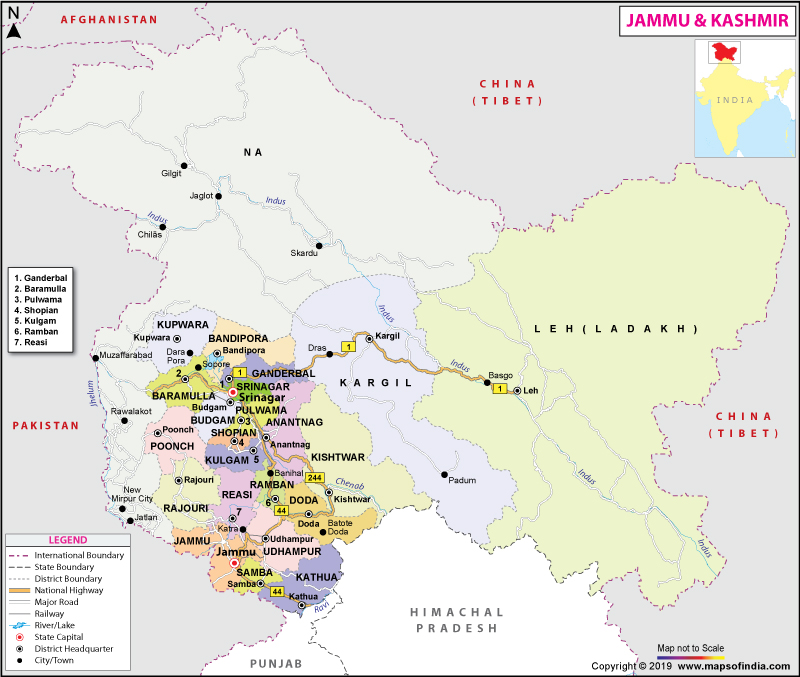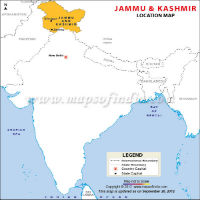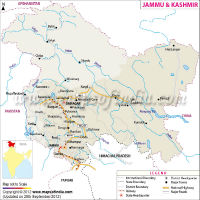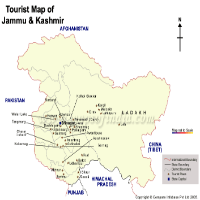About Jammu and Kashmir
On August 5, 2019, there were sweeping constitutional changes pertaining to the Indian State of Jammu and Kashmir. The state has bifurcated, and instead of the state of Jammu and Kashmir, two Union Territories, the UT of Jammu & Kashmir and the UT of Ladakh were created on October 31, 2019. MyIndia has updated the new maps of the two union territories.
Jammu & Kashmir (J&K) is the northern most state in India. It is surrounded on the north by Afghanistan and China, on the east by China, on the south by Himachal Pradesh and Punjab in India, and on the west by the North-West Frontier Province and the Punjab Province of Pakistan. J&K covers an area of 222,236 sq km (85,805 sq mi).
The state comprises three regions: the foothill plains of Jammu; the lakes and blue valleys of Kashmir rising to alpine passes, the high altitude plains and starkly beautiful mountains of Ladakh which lie beyond those passes. The Indus river flows through Kashmir and the Jhelum river rises in the northeastern portion of the territory.
Kashmir possesses a more equable climate than that of southern and central India. The beautiful Valley is a noted resort region. While Srinagar is J&K's summer capital, Jammu is the winter capital.
| Facts on Jammu & Kashmir | |
|---|---|
| Official Website | www.jkgad.nic.in |
| Date of Formation | Oct 26, 1947 |
| Area | 222,236 sq km |
| Density | 124/Km2 |
| Population (2011) | 12,541,302 |
| Males Population (2011) | 6,640,662 |
| Females Population (2011) | 5,900,640 |
| No. of District | 22 |
| Capital | Srinagar ( in Summer) and Jammu (in Winter) |
| Rivers | Chenab, Jhelum, Indus, Zanskar, Suru, Nubra, Shyok |
| Forests & National Park | Dachigam NP, Hemis High Alititude NP |
| Languages | Urdu, Hindi, Punjabi, Dogri, Kashmiri, Balti, Ladakhi, Purig, Gurji, Dadri |
| Neighbours State | Himachal Pradesh, Punjab |
| State Animal | Hangul |
| State Bird | Black-Necked Crane |
| State Tree | Chinar |
| State Flower | Lotus |
| Net State Domestic Product (2011) | 37496 |
| Literacy Rate (2011) | 67.63% |
| Females per 1000 males | 883 |
| Assembly constituency | 87 |
| Parliamentary constituency | 6 |
History of Jammu and Kashmir
The state of Jammu and Kashmir which had earlier been under Hindu rulers and Muslim Sultans became part of the Mughal Empire under Akbar. After a period of Afghan rule from 1756, it was annexed to the Sikh kingdom of Punjab in 1819. In 1846 Ranjit Singh handed over the territory of Jammu to Maharaja Gulab Singh. After the decisive battle of Sabroon in 1846, Kashmir also was handed over to Maharaja Gulab Singh under the Treaty of Amritsar.
In 1947, the state became the subject of an armed attack from Pakistan and Maharaja acceded to India on October 26, 1947 by signing the instruments of accession. India approached the then UN in January 1949. Kashmir has been the centre of contention between India and Pakistan ever since. Separatist movements have torn the peaceful fabric of the state for over a decade.
Demographics
As per Census 2011, the population of Jammu and Kashmir is 1,25,41,302. The majority of the population in the state belongs to the Muslim community. Islam is practised predominantly here but Hindus, Buddhists and Sikhs communities are also present in the state. The Hindus are also divided into different groups such as Rajputs, Brahmans, Jats and Khatris. The Kashmir valley also had a population belonging to the community known as Kashmiri Brahmins or Kashmiri Pandits. As per the Central Intelligence Agency estimate, majority of the Kashmiri Pandits were internally displaced due to the political tensions, riots, and economic reasons.
Geography
The state has an altitude from 395 meters to 6910 meters. It has a varied climate which is mainly because of its rugged topography. The climate in summer is mild owing to the rainfall that takes place on the outer hills and plains. The temperature falls as moisture laden winds strike the high peaks. The Valley being on a higher altitude has a colder climate than that of the outer plains. In winter, the Mediterranean winds cause snowfall in the Valley. Summers are mild and of short duration while winters are cold and dry. The level of cold increases with rising altitude and eventually snowfalls occurs in the higher mountain ranges.
Economy and Infrastructure
The state has limited mineral and fossil-fuel resources, and much of these are concentrated in the Jammu region. Small reserves of natural gas are found near Jammu, and bauxite and gypsum deposits occur in the Udhampur district. Other minerals include limestone, coal, zinc, and copper. The pressure of population on land is everywhere apparent, and all available resources are utilised. The lakes and rivers provide fish, water chestnuts, hydroelectric power, and transport and are a tourist attraction. The mountains supply many kinds of timber and pasture for livestock. The Gujar and Gaddi nomads practise transhumance in the mountains, keeping sheep, goats, yaks, and ponies.
The majority of the people are engaged in subsistence agriculture of diverse kinds on terraced slopes, each crop adapted to local conditions. Rice, the staple crop, is planted in May and harvested in late September. Corn (maize), millet, pulses (legumes such as peas, beans, and lentils), cotton, tobacco and rice are the main summer crops, while wheat and barley are the chief spring crops. Many temperate fruits and vegetables are grown in areas adjacent to urban markets or in well-watered areas with rich organic soils.
Government and Politics
The Government is the supreme authority in Jammu and Kashmir and governs the 22 districts of the state. Like any other state, there are three branches in the state- executive, legislative and judiciary. The executive branch is led by the Governor who is also the head of the state. The executive powers are vested in the Chief Minister of the state. The state has 89 members in the Lower House (Vidhan Sabha) and 36 members in the Upper House (Vidhan Parisahd).
Kashmir Conflict
Kashmir conflict is a land conflict between India and Pakistan. It's a disputed land which is divided between India and Pakistan which started right after partition in 1947. And China is also involved in the conflict as it holds approximately 15 per cent of the land. India occupies approximately 55 per cent of the land, whereas Pakistan holds approximately 30 per cent of the land.
Administrative Divisions
Jammu and Kashmir is divided into three divisions -Jammu, Kashmir Valley and Ladakh. These are further divided into 22 districts. They are Anantnag, Badgam, Bandipora, Baramulla, Doda, Ganderbal, Jammu, Kargil, Kathua, Kishtwar, Kupwara, Kulgam, Leh, Poonch, Pulwama, Rajauri, Ramban, Reasi, Samba, Shopian, Srinagar and Udhampur. The state has two municipal corporations, 9 municipal councils and 21 municipal boards.
| Click to View large Map |
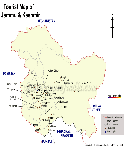 |
| Jammu and Kashmir Travel Map |
Society and Culture
The population of Jammu and Kashmir has the highest proportion of Muslims of any Indian state, about two-thirds of the total. Hindus constitute most of the remaining third, and there are small minorities of Sikhs and Buddhists. Urdu is the state's official language. Jammu and Kashmir has the distinction of having multifaceted, variegated and unique cultural blend, making it distinct from the rest of the country, not only from the different cultural forms and heritage, but from geographical, demographically, ethical, social entities. Its different cultural forms like art and architecture, fair and festivals, rites and rituals, seer and sagas, language and mountains, embedded in ageless period of history, speak volumes about the unity and diversity with unparalleled cultural cohesion and cultural service. While Kashmir has been the highest learning centre of Sanskrit and Persian where early Indo-Aryanic civilization has originated and flourished, it has also been the embracing point of the advent of Islam in India.
Ladakh on the other hand, has been the highest and living centre of Tantrayan Buddhism. Jammu, the same way, has been the seat of Rajas and Maharajas which have cemented and enriched the cultural, historical and social bonds of all these diverse ethnic and linguistic divisions of the state. The ancient archeological monuments and remnants bear testimony to the distinct cultural traditions of the state.
Language
The main languages spoken in the state of Jammu and Kashmir are Kashmiri, Urdu, Pahari, Dogri, Balti, Gojri, Ladakhi, Shina and Pashto. Nevertheless, Urdu written in the Persian script is the official language of Jammu and Kashmir.
Food
Food is a significant part of any culture. Kashmir not only soothing to the eyes but also for the taste buds. Some of the mouthwatering delicacies from this region are: Rogan Josh, Modur Pulav Matschgand, Yakhni or Yoghurt Lamb Curry, Dum Olav, Kashmiri Muji Gaad, Aab Gosht, Goshtaba.
Education
The literacy rate in Jammu and Kashmir as per the Census 2011 is 68.74 percent. The education in the state is divided into different levels - primary, high secondary, college and university level. The public and private schools in the state are either affiliated to Jammu and Kashmir State Board of School Education (JKBOSE) or Central Board of Secondary Education (CBSE). There are many institutes and universities which offer higher education in the state such as Shri Mata Vaishno Devi University, Government College of Engineering and Technology and Islamic University of Science & Technology etc.
Jammu and Kashmir Tourism
The Kashmir valley is described as a paradise on earth. Chashma Shahi Springs, Shalimar Bagh, Dal Lake, etc in Srinagar; Gulmarg, Pahalgam, Sonamarg, etc in the valley; Vaishno Devi temple and Patnitop near Jammu, etc are important tourist centres in the state. Tourism played a vital part in the economy of Kashmiri before the insurgency in 1989. After this period, tourism was hit severely. In the recent years, the decrease in state violence has rebounded and boosted the state tourism. In 2011, more than a million tourists were reported to have visited Jammu and Kashmir.More Detail>>
Hotels of Jammu and Kashmir
The state is home to both star and non star category hotels catering to the needs of the tourists Besides, it has resorts, restaurants and cafes which cater to the needs of all segments of travelers. Hotels in Jammu and Kashmir offer the highest degree of comfort to guests and make it possible to meet their maximum satisfaction. Tourists on various budgets can easily book a room in any segments of hotels in J&K. More Detail>>
Transport
Travelling in Jammu and Kashmir is not very difficult as it is easily reachable through different modes of transport. By air, the state is reachable through the flights which operate from other cities to Srinagar and Leh. The railway line which passes through the state ends at Udhampur from where one can take a bus or other vehicles to reach different places. By road, the state can be reached through two different routes, via Manali till Leh or via Jammu till Srinagar.
Last Updated on : July 17, 2019
